The patchwork in translation from English means "product from rags". Skillfully folding multi-colored pieces of fabric, you can get a bright positive baby blanket, under which the child will be easy and comfortable to euthanize. Only at first glance, such products can seem like a chaotic set of rags; in fact, the patchwork is a fascinating art of sewing with a large number of techniques. And if you look closely, one of them can be seen in any children's blanket.
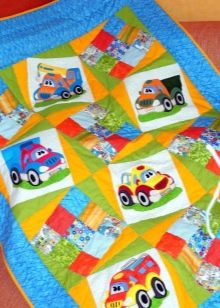


Features
Patchwork is an ancient skill, the appearance of which can be attributed to the time of the invention of the fabrics themselves. The thrifty housewife did not throw away precious scraps of material, but sewn them into canvases for further use. Museums around the world have historical exhibits confirming the interest of our ancestors in the preparation of patchwork. In the Cave of a Thousand Buddhas, a carpet was found sewn from fragments of robes of pilgrims; it dates back to the X century. In one of the museums of Egypt, a canvas made of pieces of leather is presented, the appearance of which dates back to 980 BC.
A feature of patchwork art is its uniqueness. Of the many scraps, it is impossible to fold two identical blankets, so each product is exclusive. There are other advantages of patchwork technology:
- only threads are spent on the creation of the product, and the canvas itself is assembled from scraps;
- making flaps, you can sew blankets of different sizes, even for custom children's beds;
- any fantasies are realized during work, and the more peculiar they are, the more the craftswoman will be able to surprise the final result.


A colorful pattern of paintings adds mood, it brings comfort to any home. A patchwork-style quilt can be supported by a mosaic pattern on the wall, a bedside rug made from pieces of cloth or the same colorful lampshade. The main thing is not to overdo it, otherwise the original interior will turn into a clumsy and tasteless atmosphere.
So that the blanket does not look unsystematic, craftswomen put certain logic into the selection of pattern and color. For example, the entire ornament is built around a central plot applique, or flaps are selected that match the dominant shade of the children's room. The pattern of the blanket should not put pressure on vision or create an imbalance in the interior, so designers recommend choosing several primary colors and 2-3 background shades for its creation. Variegation and many small details are allowed in small children's rooms.
A blanket for a large room is formed from large flaps connected by a common storyline or making up a common ornament.
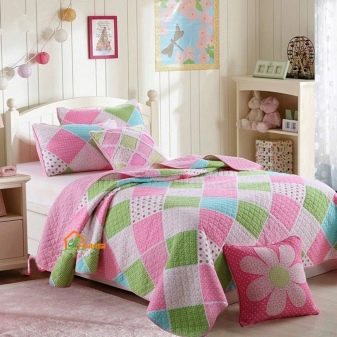
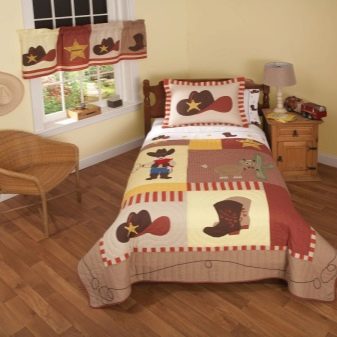
What are they?
Patchwork quilts for children are very diverse.. They are saturated with color, contain applications, thematic images on the plots of your favorite cartoons. In addition, the products can be for a boy or girl, intended for a newborn baby, or sewn in certain sizes, especially in a crib for a baby. Cheerful blankets can be appreciated by children of any age - from crumbs to a teenager.
We suggest you look at a selection of children's blankets to understand how beautiful, original, made with great love for small users they are.
- Creating a blanket for boys, they often resort to marine subjects. Here you can use white and all shades of blue. The younger the child, the weaker the tonality and the more gentle blueness present in the product. Sea plots with other shades are much less commonly used; they are addressed when it is necessary to maintain the overall color of the interior.

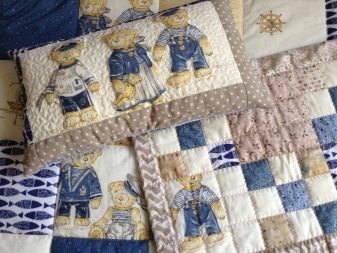
- Kids especially like blankets. with a large pattern in the center, it can be seen as a picture, including imagination and inventing adventures for your favorite characters.


- See how lovingly you can design a crumb patchwork bed. The sheet, blanket, pillow and even sidewalls are made of bright rags. A variety of funny hares will hold the baby’s gaze for a long time, because they do not repeat, but I want to consider everyone.


- For a little princess choose light and gentle colors. A large number of pillows made of pieces of fabric, bows and lace settled on a quilt with applications.


- Boys prefer products with the image of cars. For the crumbs, a calm background is selected, and an older child can be offered a riot of colors. The colorful canvas with pictures is impressive and delights children.


- Stories are also being developed for animal lovers. For example, a teenager can be offered a beautiful canvas with the image of African wild animals (safari). And for the crumbs, the plot with mischievous dogs, or kind pets, which he saw in the village of his grandmother (farm subjects), is more suitable.



- Teen will appreciate the bedspread with photographs depicting family memorable events. The canvas is sewn from squares containing non-repeating plots.
For kids, each such square can become a favorite frame from the cartoon.


- Creating children's blankets, quite often resort to applications, they neutralize the diversity of the flaps and interest the kids with a specific topic, as they often depict animals, their favorite technique or characters from cartoons.

- With extraordinary love, a complex blanket for the girl was made using many techniques. It does not contain a specific plot, but gives out a good taste and high skill of the author.

Tech Overview
Out of bands
This type is considered the simplest technique, since it’s easy to sew the same stripes together, even a novice craftswoman. For the technique of stitching strips, the material is prepared in advance. Cut out identical pieces in the form of elongated rectangles from pieces of fabrics of different colors and structures, and then sew them together. In the center of such a blanket, you can put a large square with applications.


Of squares
Making blankets from squares is as easy as creating from stripes. A similar technique belongs to one of the oldest. But this applies to flaps of the same size. If squares of different sizes are used in the product, you will need a scheme with which the working material is laid out. The pattern is chosen by the craftswoman to her taste: it can resemble a chessboard, alternate color in rows or look chaotic.
The squares are sewn with sidewalls to each other or a more complex version of stepwise stitching is selected when one flap begins to be sewn from the middle of the edge of the second. The figure in this case resembles the laying of ceramic tiles. A similar stitching technique can be used to make a web of triangles or rectangles. In the first case, it is better to choose isosceles figures. High-class craftswomen with the help of geometrical flaps are able to create “pixel” portraits similar to photographs.


"Well"
A beautiful peculiar style of "well" is also called "American Square"It was very popular in America several centuries ago. The Europeans also brought fame to him, borrowing equipment from overseas. The product is based on a small square located in the center of the blanket, larger squares gradually build up around it, stitched in size in increasing order. If you look at the canvas from above, the illusion of a well laid out of logs is created.
This technique gives the visual volume and depth of the picture, especially if you use the color effects correctly.

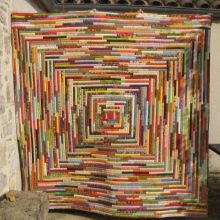

Watercolor
In this technique, color is important, not the shape of the flaps. A watercolor blanket can consist of squares, stripes or shapeless segments, but they are all united by one color scheme, as if they were painted with watercolors and created by the artist’s brush.


Of hexagons
The quilt is sewn from the same size hexagons cut from flaps. If you introduce shades of honey color into the canvas, it will resemble a honeycomb. But most often, a harmonious hexagon is used to create a floral or star blanket, less often other artistic images are created.


"Lyapochikha"
The most beautiful and voluminous equipment used for many years in Russia. The “blotter” blanket is made up of tiny scraps that hang from the canvas with the free end. Pieces of tissue rolled into a tube give even greater volume. The creation of such a product is hard painstaking work, since you have to work with a large number of small parts. Thanks to the selection of various shades, it is possible to make paintings from flaps. They, like paintings painted in oil paints, look amazingly beautiful if you move away from them at a distance.


Materials
There are no restrictions on the selection of material for the patchwork style, most importantly, harmony in the combination of texture and color. As for children's blankets, there are certain recommendations for the use of fabrics. For small users, natural products are predominantly chosen, soft, tactilely pleasant, with environmentally friendly dyes, ensuring complete safety for the kids. The following fabrics can be used to decorate children's bedrooms.
- Cotton. Strong and natural material, from it durable and beautiful blankets are obtained. Cotton is used to produce many types of fabrics.
- Flannel. Soft, soft-touch fabric made from cotton threads. Often used in baby products.
- Linen. Dense rough material with a high degree of hygroscopicity. Suitable for summer country blankets, ethno.
- Kulirka. The thinnest and smoothest cotton jersey, a touch that children really like.
- Silk. Natural silk is beautiful, but very expensive, even pruning is rarely seen. Its sliding texture is not to everyone's taste. But for oriental styles, silk is perfect. The same specifications apply to satin products.
- Fleece. The fabric is synthetic, but soft and light, pleasant to the touch, does not require complicated care. The bottom layer of the blanket can be made from natural material, and the top - from fleece flaps.
- Chintz. Strong cotton fabric of various, mainly bright colors. Bedspreads are inexpensive and elegant.



In addition to fabrics, a knitted fabric made in the form of motley fragments is used to create children's blankets in the patchwork style.
Dimensions
The sizes of baby blankets vary. The patchwork technique allows you to make products of any parameters, from envelopes for newborns to teenage bedspreads on a single or one and a half bed. In order for the blanket to match the size of the rest of the bedding, certain standards are nevertheless available.
- Single Products - 110x140 cm. For the smallest, square options are made 110x110, 120x120, 130x130 cm.
- One and a half blankets - 135x200 cm or 140x210 cm.
As for European standards, another 10 or 15 cm should be added to the above parameters. Many craftswomen prefer to sew non-standard blankets that are comfortable for a particular child and designed for his berth.
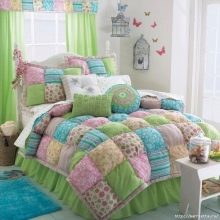

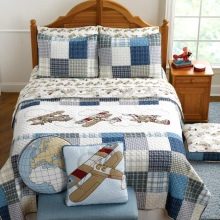
How to sew with your own hands?
- Using a template, a pattern of the future flap is applied to the fabric or trim and cut out. To create a planned ornament, each element is numbered.
- The flaps are ironed and, taking into account the numbers, are sewn together, forming a seamless canvas.
- The lining is laid out face down, a layer of padding polyester is placed on it, and a patchwork coating is placed on top.
- All three layers are sewn together using a machine.
- The edge seam is masked by a fringing.
- Quilting the finished product can be done manually.



A blanket sewn with love will decorate the nursery, give the baby a healthy rest and beautiful color dreams.
See how to sew a patchwork-style baby blanket in the next video.










